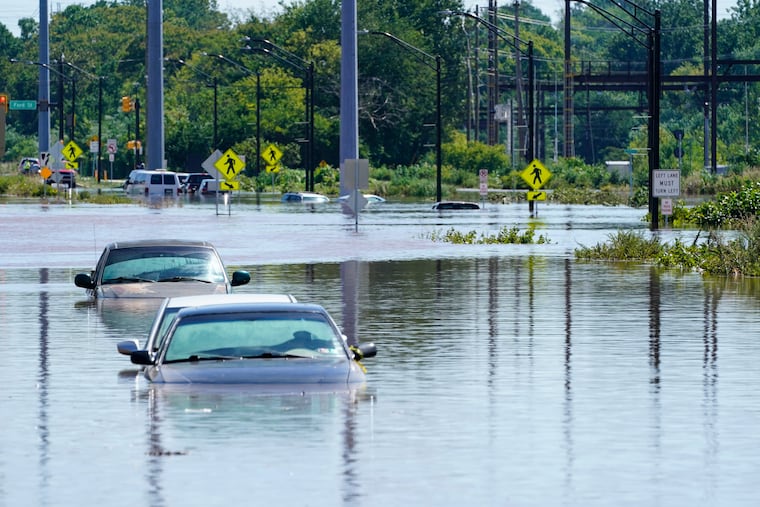When the rains come
Floods in Western Pennsylvania are nothing new. But we’ve lived here for 36 years, and the drenching rains come more frequently now.

I am afraid of the sound of rain.
Not a drizzle, a pitter patter or, as the Irish say, a fine soft day. I’m afraid of the roar of a relentless rain and a raging creek — the deluge that precedes the flood. A sound so loud I can yell at someone five feet across the creek and they can barely hear me. When I can’t distinguish what is rain from what is creek. Because I, and others who live far from a coast, have been hit by devastating floods of late — here in Pennsylvania, in Kentucky, West Virginia, and Vermont, to name but a few.
When the rains come at night, I’m particularly afraid. I look out our bedroom window, where even in the dark I can often judge from the contour of our serpentine creek how much it is swelling and how high it has jumped its bank. But I can’t tell if the pond has breached or whether the dock is submerged, signs that the house is in danger. So I go a little crazy, race around the inside of the house checking likely access points. I flick on the outside lights to see how close the water is to the basement door. Sleep does not come easily.
The creek is close; it runs alongside the house, in front of the barn and next to the driveway, but the creek is not the only problem. Water races so fast down our steep driveway that it becomes a second river, jumps a stonewall, turns that wall into a waterfall and a flagstone patio into a swimming pool. Terra-cotta flower pots are picked up, dumped over, and swept downhill. The combination of creek and newly formed river leaves a path of destruction: fallen tree limbs, rocks, uprooted plants, and so much sediment that the pond turns the color of chocolate milk.
I was not afraid of the sound of water until one day about 20 years ago, when my children and I were watching a movie in the basement of this old farmhouse and one of them said: “Mom, what’s that noise?” and the water overtook us. The downstairs bedroom was flooded, as was my husband’s office and the laundry room. The water just kept coming. We’d never had that happen before.
We live partway up the mountain, so it’s not nearly as bad for us as for those who live by the river in the middle of town. When the rains come, I think of my children’s saintly first-grade teacher, who lives on the banks of Loyalhanna Creek. I shudder to think of what she and her family go through every time.
Floods in Western Pennsylvania are not new. We have lots of rivers and the terrain is hilly. Forty-five minutes away from here is the site of Pennsylvania’s most famous flood, the Johnstown Flood of 1889, a horrendous incident that took the lives of 2,209 people. But we’ve lived here for 36 years, and the drenching rains come more frequently now, often with high winds, fallen trees, and a loss of power. Flash flood warnings are frequent.
The timing is changing, too. Once the floods came in May or June, maybe July, but last August — usually our dry month — we had a flood, and we just avoided one in April. I was driving on Route 30, the old Lincoln Highway, where I saw waterfalls cascading down the hills into the gorge. Smaller roads were closed, buses thwarted, and school canceled. Pittsburgh, an hour away, broke its daily rainfall record on April 9 with 2.77 inches of rain. The first 12 days of April saw more rain in Pittsburgh than any other month on record.
The original part of this old house, built about 1860, is made of logs, large beams, and a stone fireplace. It was placed on a dirt road at the bottom of three hills, out of the wind, where farmers sited houses then. It was not built to withstand today’s storms, but we’ve tried our best to preserve it, to keep the water at bay.
In the basement bedroom there was a clue that the previous owner — who lived here from the 1940s until the 1980s — may have had a problem with water as there was a strip of metal at the bottom of the door. But our problem is so much worse now that we’ve had to change that door into a window.
We created a swale to divert the water away from the house and we’ve placed an unsightly row of sandbags that intermingle with my lovely white tulips at the basement window. We added drains along the driveway that we check assiduously before a storm to make sure they are not clogged with leaves or sticks.
The water from our unnamed and seemingly inconsequential little creek runs into the Loyalhanna Creek, which feeds the Conemaugh River, streams into the Kiskiminetas River, joins the Allegheny River, meets the Ohio River and flows into the Mississippi, all of which ends up in the Gulf of Mexico.
We hear all the time about sea level rise, but those of us who live inland are connected by creeks and streams and rivers. And when the rains come, I bet they, too, have come to dread sounds they once loved — rain on the roof, a rising creek, thunder — the sounds of an impending storm.
Daryln Brewer Hoffstot is a freelance writer and the author of “A Farm Life: Observations From Fields and Forests.”